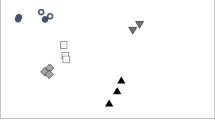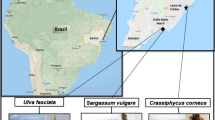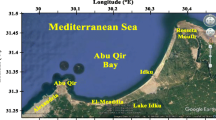Abstract
The influence of drying (sun-drying and shade-drying) on the elemental composition of two brown seaweeds (Treptacantha abies-marina, Cystoseira humilis) and two red seaweed species (Asparagopsis armata and Asparagopsis taxiformis) harvested in the Faial Island (Azores Islands, Portugal) was assessed. The contents of sixteen nutritionally and toxicologically relevant elements were determined: sodium (Na), magnesium (Mg), phosphorus (P), sulphur (S), potassium (K), calcium (Ca), chromium (Cr), manganese (Mn), iron (Fe), copper (Cu), zinc (Zn), arsenic (As), bromine (Br), cadmium (Cd), iodine (I), and lead (Pb). While the most abundant macroelement in T. abies-marina and C. humilis was K (64.1–71.0 g kg−1 dw), for both Asparagopsis species, this position was held by Na (85.6–115.3 g kg−1 dw). Iodine content did not surpass 0.1 g kg−1 dw in the brown seaweeds and varied between 4.6 and 5.7 g kg−1 dw in Asparagopsis species. The I Dietary Reference Intake may be ensured by less than 1 g of dried A. armata or A. taxiformis per week. For T. abies-marina and C. humilis, 10.5 g or more of dried seaweed per week may be required. However, excessive I can be a health risk: 1–2 g of dried A. armata or A. taxiformis per week may result in I-related health risks. Moreover, there are As-related health risks for the consumption of C. humilis and, especially, T. abies-marina. The type of drying did not show a clear effect upon the elemental composition.

Similar content being viewed by others
Data availability
Data is made available upon request.
References
Afonso C, Cardoso C, Ripol A, Varela J, Quental-Ferreira H, Pousão-Ferreira P, Ventura MS, Delgado IM, Coelho I, Castanheira I, Bandarra NM (2018) Composition and bioaccessibility of elements in green seaweeds from fish pond aquaculture. Food Res Int 105:271–277
Afonso C, Guarda I, Mourato M, Martins LL, Fonseca I, Gomes R, Matos J, Gomes A, Bandarra NM, Cardoso C (2020) Treptacantha abies-marina (S.G. Gmelin) Kützing: characterization and application as a whole food ingredient. J Aq Food Prod Technol 29:964–980
Afonso C, Matos J, Campos AM, Gomes R, Coelho I, Delgado I, Castanheira I, Bandarra NM, Cardoso C (2021) Elemental composition and bioaccessibility of three insufficiently studied Azorean macroalgae. Int J Food Sci Technol 56:330–341
Algaebase (2018) Global algal database of taxonomic, nomenclatural and distributional information. http://www.algaebase.org/ Accessed on 19th September 2018
Al-Shwafi NA, Rushdi AI (2008) Heavy metal concentrations in marine green, brown, and red seaweeds from coastal waters of Yemen, the Gulf of Aden. Environ Geol 55:653–660
Alves C, Pinteus S, Horta A, Pedrosa R (2016) High cytotoxicity and anti-proliferative activity of algae extracts on an in vitro model of human hepatocellular carcinoma. Springerplus 5:1339
Andersson M, Karumbunathan V, Zimmermann MB (2012) Global iodine status in 2011 and trends over the past decade. J Nutr 142:744–750
Andrade PB, Barbosa M, Matos RP, Lopes G, Vinholes J, Mouga T, Valentão P (2013) Valuable compounds in macroalgae extracts. Food Chem 138:1819–1828
AOAC (2000) Official methods of analysis, 17th edn. Association of Analytical Chemists, Gaithersburg, MD USA
Barreto C, Mendonça E, Gouveia V, Anjos C, Medeiros JS, Seca A, Neto AI (2012) Macroalgae from S. Miguel Island as a potential source of antiproliferative and antioxidant products. Arquipelago Life Mar Sci 29:53–58
Caliceti M, Argese E, Sfriso A, Pavoni B (2002) Heavy metal contamination in the seaweeds of the Venice lagoon. Chemosphere 47:443–454
CEN, Comité Européen de Normalisation (2007) EN 15111:2007 Foodstuffs - determination of trace elements - determination of iodine by ICP-MS (inductively coupled plasma mass spectrometry). Comité Européen de Normalisation: Brussels, Belgium. 12 p
Chan JC-C, Cheung PC-K, Ang PO (1997) Comparative studies on the effect of three drying methods on the nutritional composition of seaweed Sargassum hemiphyllum (Turn) C. Ag. J Agric Food Chem 45:3056–3059
Circuncisão AR, Catarino MD, Cardoso SM, Silva AMS (2018) Minerals from macroalgae origin: health benefits and risks for consumers. Mar Drugs 16:400
Custódio L, Silvestre L, Rocha MI, Rodrigues MJ, Vizetto-Duarte C, Pereira H, Barreira L, Varela J (2016) Methanol extracts from Cystoseira tamariscifolia and Cystoseira nodicaulis are able to inhibit cholinesterases and protect a human dopaminergic cell line from hydrogen peroxide-induced cytotoxicity. Pharm Biol 54:1687–1696
EFSA Contam Panel, EFSA Panel on Contaminants in the Food Chain (2014) Scientific opinion on the risks to public health related to the presence of chromium in food and drinking water. EFSA J 12:3595
EFSA, European Food Safety Authority (2011) EFSA J 9:1975
EFSA, European Food Safety Authority (2013) Scientific opinion on dietary reference values for manganese. EFSA J 11:3419
EFSA, European Food Safety Authority (2014) Scientific opinion on dietary reference values for zinc. EFSA J 12:3844
EFSA, European Food Safety Authority (2015a) Scientific opinion on dietary reference values for copper. EFSA J 13:4253
EFSA, European Food Safety Authority (2015b) Scientific opinion on dietary reference values for iron. EFSA J 13:4254
El-Baroty GS, Moussa MY, Shallan MA, Ali MA, Sabh AZ, Shalaby EA (2007) Contribution to the aroma, biological activities, minerals, protein, pigments and lipid contents of the red alga: Asparagopsis taxiformis (Delile) Trevisan. J Appl Sci Res 3:1825–1834
EU (European Union) (2012) Regulation 744/2012 amending Annexes I & II to Directive 2002/32/EC of the European Parliament and of the Council as regards maximum levels for arsenic, fluorine, lead, mercury, endosulfan, dioxins, Ambrosia spp., diclazuril and lasalocid A sodium and action thresholds for dioxins. OJ L 219:5–12
FAO/WHO (1988) Report of the joint meeting of the FAO Panel of Experts on Pesticide Residues in Food and the Environment and a WHO Expert Group on Pesticide Residues. FAO, Geneva
FAO/WHO, Joint FAO/WHO Expert Committee on Food Additives (2010) Seventy third meeting, Geneva, 8–17 June 2010. Summary and Conclusions. Issued 24th June 2010
Fonseca I, Guarda I, Mourato M, Martins LL, Gomes R, Matos J, Gomes-Bispo A, Bandarra NM, Cardoso C, Afonso C (2021) Undervalued Atlantic brown seaweed species (Cystoseira abies-marina and Zonaria tournefortii): influence of treatment on their nutritional and bioactive potential and bioaccessibility. Eur Food Res Technol 247:221–232
Francesconi KA, Edmonds JS (1996) Arsenic and marine organisms. Adv Inorg Chem 44:147–189
Francisco J, Cardoso C, Bandarra N, Brito P, Horta A, Pedrosa R, Gil MM, Delgado IM, Castanheira I, Afonso C (2018) Bioaccessibility of target essential elements and contaminants from Fucus spiralis. J Food Comp Anal 74:10–17
Genovese G, Tedone L, Hamann MT, Morabito M (2009) The Mediterranean red alga Asparagopsis: a source of compounds against Leishmania. Mar Drugs 7:361–366
Gupta S, Cox S, Abu-Ghannam N (2011) Effect of different drying temperatures on the moisture and phytochemical constituents of edible Irish brown seaweed. LWT Food Sci Technol 44:1266–1272
Haug A (1961) The affinity of some divalent metals to different types of alginates. Acta Chem Scand 8:1794–1795
Holdt SL, Kraan S (2011) Bioactive compounds in seaweed: functional food applications and legislation. J Appl Phycol 23:543–597
Ifie I, Olatunde S, Ogbon O, Umukoro JE (2021) Processing techniques on phytochemical content, proximate composition, and toxic components in duckweed. Int J Veg Sci 27:294–302
IOM (Institute of Medicine) (2001) Dietary Reference Intakes for vitamin A, vitamin K, arsenic, boron, chromium, copper, iodine, iron, manganese, molybdenum, nickel, silicon, vanadium, and zinc. Food and Nutrition Board. National Academy Press, Washington, D.C.
IOM (Institute of Medicine) (2004) Dietary Reference Intakes (DRIs): recommended intakes for individuals. Vitamins. Institute of Medicine (https://web.archive.org/web/20091030004039/http://iom.edu/en/Global/News%20Announcements/~/media/Files/Activity%20Files/Nutrition/DRIs/DRISummaryListing2.ashx). Accessed 18 May 2020
Julião DR, Afonso C, Gomes-Bispo A, Bandarra NM, Cardoso C (2021) The effect of drying process on undervalued brown and red seaweed species: bioactivity alterations. Phycol Res 69:246–257
Kadam U, Álvarez C, Tiwari B, Donnell CPO (2015) Processing of seaweeds. In: Tiwari BK, Troy DJ (eds) Seaweed sustainability: food and non-food applications. Academic Press, Amsterdam, pp 61–78
Kolb N, Vallorani L, Milanovic N, Stocchi V (2004) Evaluation of marine algae wakame (Undaria pinnatifida) and kombu (Laminaria digitata japonica) as food supplements. Food Technol Biotechnol 42:57–61
Kladi M, Vagias C, Roussis V (2004) Volatile halogenated metabolites from marine red algae. Phytochem Rev 3:337–366
La Barre S, Potin P, Leblanc C, Delage L (2010) The halogenated metabolism of brown algae (Phaeophyta), its biological importance and its environmental significance. Mar Drugs 8:988–1010
Laird BD, Chan HM (2013) Bioaccessibility of metals in fish, shellfish, wild game, and seaweed harvested in British Columbia, Canada. Food Chem Toxicol 58:381–387
Le Lann K, Jégou C, Stiger-Pouvreau V (2008) Effect of different conditioning treatments on total phenolic content and antioxidant activities in two Sargassacean species: comparison of the frondose Sargassum muticum (Yendo) Fensholt and the cylindrical Bifurcaria bifurcata R Ross. Phycol Res 56:238–245
Ma Z, Lin L, Wu M, Yu H, Shang T, Zhang T, Zhao M (2018) Total and inorganic arsenic contents in seaweeds: absorption, accumulation, transformation and toxicity. Aquaculture 497:49–55
Mabeau S, Fleurence J (1993) Seaweed in food products: biochemical and nutritional aspects. Trends Food Sci Technol 4:103–107
Machado L, Magnusson M, Paul NA, de Nys R, Tomkins N (2014) Effects of marine and freshwater macroalgae on in vitro total gas and methane production. PLOS One 9:e85289
Machado L, Kinley RD, Magnusson M, de Nys R, Tomkins NW (2015) The potential of macroalgae for beef production systems in Northern Australia. J Appl Phycol 27:2001–2005
Manev ZK, Petkova NT (2021) Component composition and antioxidant potential of Cystoseira barbata from the Black Sea. Bull Transilvania University of Braşov Ser II 14(63):163–172
NRC (National Research Council) (2000) Dietary Reference Intakes for vitamin A, vitamin K, arsenic, boron, chromium, copper, iodine, iron, manganese, molybdenum, nickel, silicon, vanadium, and zinc. National Academies Press: Washington, DC pp 258–259
Nunes N, Valente S, Ferraz S, Barreto MC, de Carvalho MAAP (2018) Nutraceutical potential of Asparagopsis taxiformis (Delile) Trevisan extracts and assessment of a downstream purification strategy. Heliyon 4:e00957
Oucif H, Benaissa M, Mehidi SA, Prego R, Aubourg SP, Abi-Ayad S-ME-A (2020) Chemical composition and nutritional value of different seaweeds from the west Algerian coast. J Aq Food Prod Technol 29:90–104
Pereira L (2016) Edible seaweeds of the world. CRC Press, Boca Raton, Boca Raton, p 453
Roque BM, Brooke CG, Ladau J, Polley T, Marsh LJ, Najafi N, Pandey P, Singh L, Kinley R, Salwen JK, Eloe-Fadrosh E, Kebreab E, Hess M (2019a) Effect of the macroalgae Asparagopsis taxiformis on methane production and rumen microbiome assemblage. Anim Microbiome 1:1–14
Roque BM, Salwen JK, Kinley R, Kebreab E (2019b) Inclusion of Asparagopsis armata in lactating dairy cows’ diet reduces enteric methane emission by over 50 percent. J Clean Prod 234:132–138
Rupérez P (2002) Mineral content of edible marine seaweeds. Food Chem 79:23–26
Santos S, Ungureanu G, Volf I, Boaventura RAR, Botelho CMS (2018) Macroalgae biomass as sorbent for metal ions. In: Popa V, Volf I (eds) Biomass as renewable raw material to obtain bioproducts of high-tech value. Elsevier, Amsterdam, pp 69–112
SCF (Scientific Committee on Food) (2002) Opinion of the scientific committee on food on the tolerable upper intake level of zinc. SCF/CS/NUT/UPPLEV/62 Final, 18 pp
SCF (Scientific Committee on Food) (2003) Opinion of the scientific committee on food on the tolerable upper intake level of copper. 10 pp
Squadrone S, Brizio P, Battuello M, Nurra N, Sartor RM, Riva A, Staiti M, Benedetto A, Pessani D, Abete MC (2018) Trace metal occurrence in Mediterranean seaweeds. Environ Sci Pollut Res 25:9708–9721
Van Netten C, Cann SAH, Morley DR, van Netten JP (2000) Elemental and radioactive analysis of commercially available seaweed. Sci Total Environ 255:169–175
Vizetto-Duarte C, Custódio L, Barreira L, da Silva MM, Rauter AP, Albericio F, Varela J (2016) Proximate biochemical composition and mineral content of edible species from the genus Cystoseira in Portugal. Bot Mar 59:251–257
World Health Organization and WHO (1989) Toxicological evaluation of certain food additives and contaminants. WHO, Geneva
Acknowledgements
The authors are grateful to seaExpert for the collection of the seaweed samples and to Artur Oliveira for the identification and harvesting of the seaweed samples as well as supplied photos.
Funding
This work was supported by the following grants: Ref. SFRH/BPD/102689/2014 (“Fundação para a Ciência e a Tecnologia”, FCT) for Carlos Cardoso and DIVERSIAQUA (MAR2020, Ref.: 16–02-01-FEAM-66) for Cláudia Afonso. The experimental work was funded by the projects AQUAMAX (Ref.: 16–02-01-FMP-0047) and I9 + PROALGA (Ref.: 16–01-03-FMP-0011).
Author information
Authors and Affiliations
Corresponding author
Ethics declarations
Conflict of interest
The authors declare no competing interests.
Additional information
Publisher's note
Springer Nature remains neutral with regard to jurisdictional claims in published maps and institutional affiliations.
Rights and permissions
About this article
Cite this article
Afonso, C., Julião, D.R., Pinto, E. et al. The effect of drying process on undervalued brown and red seaweed species: elemental composition. J Appl Phycol 34, 1749–1761 (2022). https://doi.org/10.1007/s10811-022-02741-y
Received:
Revised:
Accepted:
Published:
Issue Date:
DOI: https://doi.org/10.1007/s10811-022-02741-y




